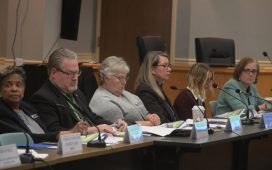Just before I made the trip north to Saratoga, the Keeneland Library held another of its duplicate book sales. These are famous in our household and are the source for a very extensive racing library in our basement, most of which we haven’t read but find as helpful reference material. I imagine the wonderful staff at the Keeneland Library are happy to see me coming because I tend to pick up the material no one else is really interested in. This year, it was a pair of pamphlets containing the proceedings of the Jockey Club Round Table from 1965 and 1966.\
I could write an endless series looking back at old texts from racing regulatory meetings. There’s something for everyone. The odd ideas we used to have about veterinary medicine, before imaging and research caught up to the modern era. The really good ideas that turned out to be kind of messy once someone tried to implement them. The really good ideas that I’d still like someone to try.
But mostly, what I usually think is that in racing more than any other world, the more things change, the more they stay the same.
Most people would agree that the sport’s stars are quite different from the 1960s, when Kelso ruled the world, and Buckpasser and Dr. Fager did their best work. But parts of the agendas for these meetings can (and have) appeared in modern times.
In 1965, Thomas Deegan Jr., gave a presentation titled Public Relations in Thoroughbred Racing. The focus then was about the same as it is now but the framing was different.
“We have to build constantly a groundswell of favorable public opinion because while Thoroughbred racing is the largest spectator sport, and attracted 40,827,872 persons in ’64, there are many more millions whom it has not attracted yet, but who are a voice in public opinion,” Deegan said.
(For reference, Deegan was best remembered as the organizer of the World’s Fair in 1964-65 and served as a principal advisor to Lyndon Johnson. Understanding the public mindset was a basic tenet of his career.)
“The public image of Thoroughbred racing today is at the highest level it has ever attained,” he continued. “Sports writers throughout the country have praised racing as the best supervised of all sports. Yet this has made no impression whatsoever on the legislators. In all my experience of more than 40 years in the sport I have never known of a member of a legislature to defend racing or praise it as a clean sport. How can racing extend its public relations to impress legislators as having benefits other than a cow that can be constantly milked?”
The aim of public relations in racing is still the same, but now it so often feels like an attempt born out of desperation as the sport fights not to be cancelled. The number of people coming to see the sport live isn’t anything like 40 million anymore, and it’s truer now than ever that there are more people who don’t watch than people who do.
In the category of ‘good ideas’ though, Deegan touted the introduction of a closed circuit television into the press box at New York Racing Association tracks that would encourage the stewards to review decisions with the media. As I sit in the press box now, I can tell you there are TVs showing the track feed, but the stewards most definitely do not come in here and explain their decisions to us.
The following year, there was a topic discussed with some fervor which will be familiar to the modern trainer or farm manager – the challenge of recruiting and keeping staff.
While many people in the business want to call this a modern problem (often followed by the refrain of ‘people just don’t want to work anymore’), the hardboots at the table in 1966 would tell you differently. Mostly, they seemed focused on losing ‘boys’ – a shorthand for ‘exercise boys’ – who would learn to gallop on the track and leave for the racetrack once they got good. But several attendees mentioned equal challenges with keeping grooms, too. More than one bemoaned child labor laws and legal requirements to keep kids in school. Another suggested that owners, who still hired barn staff on contracts in those days, should band together and come up with one unified pay rate so those paying more wouldn’t be able to steal staff off everyone else. (Which doesn’t seem…legal?)
But mostly, the conversation came back to the same back-and-forth it does today.
“I don’t think that you’ll ever get any high type people to want to work around the race track because a man can go in the factories and make $2.50 an hour and work 40 hours a week, and nobody now wants to put in seven days a week from six o’clock in the morning until six o’clock at night, especially when he is running a horse,” said Jack Price, trainer and operator of Dorchester Equine Preparatory School. “You are not going to get good people and interested people to do this because of the opportunities. I think if we want to develop a higher type of help they would have to work a decent number of hours. We’ll have to compete with industry that way and pay that money.”
Until the current labor crisis, most farm and track jobs are six days a week instead of seven, but the point remains – people have choices now with defined hours and more time off. Price talked about the desire he’d noticed for workers to go home and spend time with their families, instead of sleeping in the tack room or a dorm. In a way, the discussion is similar today; the workforce as a whole wants to have a life outside of work, and a job with horses makes this challenging. For a long time, racing has solved this problem by relying on an immigrant labor force who are living far from their families and want to make as much money as they can to send home. But even that band-aid is beginning to show wear.
(Chelsea Hackbarth wrote about this push-and-pull a few months ago. You can read that piece here.)
In 1966, there were still horsemen who disputed this idea that people want a work/life balance (though it wasn’t called that yet).
“In the area we are in we have had an 800% increase in light industry which is attracting a lot of these boys out of high school with vocational training programs,” said Daniel G. Van Clief, breeder and owner. “It has not affected our help on the farm because the ones who work on the farm or on the race track are a certain type person and it isn’t going to change very much. Like Bull [Hancock] says, some of them may go on to college, but the rest of them stay with you and their sons stay with you … our labor problem isn’t any worse than what it was twenty years ago except for the accelerated number that are going on to college, even with the 800% increase in industry in our area.”
Instead, Van Clief suggested, the solution was to recruit young people out of school by emphasizing the great benefits to working on the farm – including pension plans, which Van Clief mentioned were standard at his farm. It’s been a long time since I worked on the farm, but I’m not sure that’s necessarily been the standard up until recently, and I know it’s not at the track.
I don’t know whether to be cynically discouraged or greet some of these repetitions with tongue-in-cheek enthusiasm. While we’ve made progress on some issues facing racing in the last 60 years, it’s startling how many topics keep coming up, and how many of the same things keep being said about them.
On the other hand though, racing has lived on despite this reinvention of wheels. I’ve read other voices from racing stakeholders past – Louis Wolfson’s treatise from 1986 is a good example – that also identify familiar problems, sometimes predicting certain doom without solutions, and still we are here. I’m not sure I think we have another 60 years of the same discussions left in us, though. This year, after watching the livestream of the Round Table, I’m hoping stakeholders may take a spin through some of the old ones, too.









